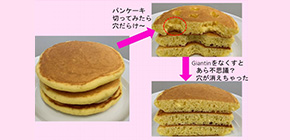
Structure-function relationship in Golgi as distribution station clarified
A group of researchers from Okayama University and the Institute of Scientific and Industrial Research of Osaka University discovered that Giantin, a Golgi membrane protein, played an important role in regulating structures of the Golgi apparatus.
Numerous small structures are contained in cytoplasm. The small structures that make up much of the cytoplasm are called organelles, which include mitochondria, ribosomes, endoplasmic reticulum (ER), Golgi apparatus, lysosomes, centrosomes, vesicles, and others.
The Golgi apparatus has a pancake-like structure of several flattened sacs, or membrane cisternae, serving as a distribution station for proteins and lipids. In many mammalian cells, the Golgi apparatus is further linked laterally and forms a ribbon-like structure of a few hundred pancakes.
In the Golgi, proteins and lipids are chemically modified, further processed, and sorted for transport to their eventual destinations. The Golgi has the function of tagging vesicles with proteins and sugar molecules, which serve as identifiers for the vesicles to be delivered to their final destinations.
It is thought that this pancake-like structure of cisternae has functional parts containing fenestrae, or pores, which increase the efficiency of the sorting and delivery process. A variety of long rod-like molecules called Golgins protrude from the surface of the Golgi. This group’s previous research showed that one of the longest Golgins, Giantin, might control the pancake-like structure.
In this study, the group examined differences in patterns of cell surfaces of the Golgi and the Giantin-knockdown Golgi, finding that Giantin knockdown structurally and functionally increases connectivity among Golgi cisternae and stacks, losing independence of individual Golgi stacks.
Using electron tomography and 3D modeling of Golgi stacks in Giantin knockdown cells, the group compared them with control cells. Giantin-knockdown cells had fewer and smaller fenestrae within each cisterna; that is, loss of Giantin altered lateral linking of the stack and lost fenestrae in cisternae of the Golgi, structurally and functionally increasing connectivity among Golgi cisternae and stacks, which made sorting difficult.
The structure-function relationship in the Golgi is not well known. This study demonstrated that Giantin is important for maintaining fenestrae in the structure of the Golgi.
It is thought that the sacs of the Golgi apparatus function to provide multiple chambers for chemical reactions and that these fenestrae allow for many reactions to take place at the same time. This idea is consistent with the findings of this study and the group’s previous study; the loss of Giantin structurally and functionally altered the Golgi apparatus as a distribution center. This group’s achievements are important in understanding the Golgi structure-function relationship in a cell.
Figure 1
The article, “The golgin protein giantin regulates interconnections between golgi stacks,” was published in Frontiers in Cell and Developmental Biology at DOI: https://doi.org/10.3389/fcell.2019.00160 .
Related links
